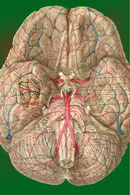|
NEUROACTIVE CHEMICALS
Neurons in the CNS produce a large number of special molecules
which function as neurotransmitters or are suspected to do so,
including acetylcholine (ACh), norepinephrine (NE), dopamine
(DA), y-aminobutyric acid (GABA), aspartic acid, glutamic acid,
glycine, and substance P. CNS neurons also synthesize a number
of neuropeptides which perform quite specific endocrine roles.
We will take a closer look at these neuroactive chemicals now.
 Acetylcholine
Acetylcholine
 Acetylcholine has long been recognized as an important
neurotransmitter. It's released by preganglionic sympathetic and
parasympathetic nerve fiber terminals as well as postganglionic
parasympathetic and certain select sympathetic fibers. It is
also the only recognized neurotransmitter at the skeletal muscle
neuromuscular junction. Unfortunately we don't have nearly as
complete a picture of the distribution of cholinergic neurons
in the CNS. There appear to be cholinergic fibers associated
with the arousal or activating systems of the brain which
project from the midbrain reticular formation, hypothalamus
striatum, and septum to the neocortex. ACh and the enzymes
necessary for its synthesis are also found in the hippocampus,
corpus striatum, and retina.
Acetylcholine has long been recognized as an important
neurotransmitter. It's released by preganglionic sympathetic and
parasympathetic nerve fiber terminals as well as postganglionic
parasympathetic and certain select sympathetic fibers. It is
also the only recognized neurotransmitter at the skeletal muscle
neuromuscular junction. Unfortunately we don't have nearly as
complete a picture of the distribution of cholinergic neurons
in the CNS. There appear to be cholinergic fibers associated
with the arousal or activating systems of the brain which
project from the midbrain reticular formation, hypothalamus
striatum, and septum to the neocortex. ACh and the enzymes
necessary for its synthesis are also found in the hippocampus,
corpus striatum, and retina.
 Acetylcholine is formed by the reaction of choline with acetyl
coenzyme A (acetyl CoA) in the presence of the enzyme choline
acetyltransferase (CAT). Since neurons can't synthesize choline,
the ultimate source of choline for ACh synthesis is the choline
of the plasma. Acetyl CoA is synthesized within presynaptic
cytoplasm by the A TP-energized reaction of acetate with CoA.
Once ACH has been synaptically released and has produced its
postsynaptic effects on membrane permeability, it is hydrolyzed
within microseconds by the enzyme acetylcholinesterase (AChE).
Interestingly enough, while negligible amounts of ACh are
reabsorbed by presynaptic terminals in the peripheral nervous
system (hydrolysis by AChE being overwhelmingly dominant), its
reuptake by the terminals in brain is considerable.
Nevertheless, its failure to be resequestered into synaptic
vesicles leaves the significance of this process in doubt.
Acetylcholine is formed by the reaction of choline with acetyl
coenzyme A (acetyl CoA) in the presence of the enzyme choline
acetyltransferase (CAT). Since neurons can't synthesize choline,
the ultimate source of choline for ACh synthesis is the choline
of the plasma. Acetyl CoA is synthesized within presynaptic
cytoplasm by the A TP-energized reaction of acetate with CoA.
Once ACH has been synaptically released and has produced its
postsynaptic effects on membrane permeability, it is hydrolyzed
within microseconds by the enzyme acetylcholinesterase (AChE).
Interestingly enough, while negligible amounts of ACh are
reabsorbed by presynaptic terminals in the peripheral nervous
system (hydrolysis by AChE being overwhelmingly dominant), its
reuptake by the terminals in brain is considerable.
Nevertheless, its failure to be resequestered into synaptic
vesicles leaves the significance of this process in doubt.
Acetate + CoA + ATP ~ acetyl CoA + AMP + 2Pi
 Catecholamines
Catecholamines
 The catecholamine neurotransmitters are norepinephrine (NE) and
dopamine (DA). The synthesis of both of these amines proceeds
from the amino acid tyrosine (Fig. 17-5). Tyrosine is converted
to 3,4-dihydroxyphenylalanine (dopa) by the enzyme tyrosine
hydroxylase. Subsequent decarboxylation by dopa decarboxylase
converts dopa to 3,4-dihydroxyphenylethylamine (dopamine). This
is as far as the synthesis proceeds in dopaminergic neurons. In
norepinephrinergic neurons, an additional step converts dopamine
to norepinephrine by action of the enzyme dopamine ,B-hydroxylase.
The catecholamine neurotransmitters are norepinephrine (NE) and
dopamine (DA). The synthesis of both of these amines proceeds
from the amino acid tyrosine (Fig. 17-5). Tyrosine is converted
to 3,4-dihydroxyphenylalanine (dopa) by the enzyme tyrosine
hydroxylase. Subsequent decarboxylation by dopa decarboxylase
converts dopa to 3,4-dihydroxyphenylethylamine (dopamine). This
is as far as the synthesis proceeds in dopaminergic neurons. In
norepinephrinergic neurons, an additional step converts dopamine
to norepinephrine by action of the enzyme dopamine ,B-hydroxylase.
 The enzymatic degradation of the two catecholamines is
illustrated in Fig. 17-6. Catechol-o-methyltransferase (COMT)
and monoamine oxidase (MAO) produce inactive products which have
little effect on receptor sites. MAO catalyzes the oxidative
deamination of norepinephrine to 3,4-dihydroxymandelic acid and
dopamine to 3,4-dihydroxyphenylacetic acid. These products are
then methylated by COMT to 3-methoxy-4-hydroxymandelic acid and
homovanillic acid, respectively. Alternatively, norepinephrine
can first be methylated to normetanephrine and then deaminated
to 3-methoxy-4-hydroxymandelic acid.
The enzymatic degradation of the two catecholamines is
illustrated in Fig. 17-6. Catechol-o-methyltransferase (COMT)
and monoamine oxidase (MAO) produce inactive products which have
little effect on receptor sites. MAO catalyzes the oxidative
deamination of norepinephrine to 3,4-dihydroxymandelic acid and
dopamine to 3,4-dihydroxyphenylacetic acid. These products are
then methylated by COMT to 3-methoxy-4-hydroxymandelic acid and
homovanillic acid, respectively. Alternatively, norepinephrine
can first be methylated to normetanephrine and then deaminated
to 3-methoxy-4-hydroxymandelic acid.
 Distribution of Norepinephrinergic Fibers
Distribution of Norepinephrinergic Fibers
The distribution of norepinephrinergic fibers in the peripheral
nervous system is limited to the majority of postganglionic
sympathetic neurons. Norepinephrine-releasing neurons in the
central nervous system have their cell bodies located in the
midbrain, pons, and medulla, primarily in the reticular
formation. Two norepinephrine systems are often described in the
mammalian brain: the
locus ceruleus system
and the
lateral tegmental system.
The
cell bodies of the former are located in the locus ceruleus, a
prominent nucleus in the brain stem reticular formation at the
level of the isthmus. This nucleus is composed entirely of
norepinephrinergic neurons. Their fibers project to the spinal
cord, brainstern, cerebellum, hypothalamus, thalamus, basal
telencephalon, and the entire neocortex. The lateral tegmental
system includes those norepinephrinergic neurons with cell
bodies located in the dorsal motor nucleus of X, the nucleus of
the solitary tract, and the adjacent and lateral tegmentum. The
fibers of this system project to the spinal cord, brainstem,
hypothalamus, thalamus, and basal telencephalon
 Distribution of Dopaminergic Fibers
Distribution of Dopaminergic Fibers
Dopaminergic systems in the CNS are more complex, numerous, and
diversely distributed than norepinephrine systems. Seven
_d_<?fla..!Jl:~I1.e~gj£ systems can be identified III the
mammalian brain.
Nigrostriatal
System The
neurons in this system project from the pars compacta of the
substantia nigra and the mediolateral tegmentum to terminate in
the caudate nucleus, putamen, and globus pallidus. A marked
reduction in dopamine content in the neostriatum (caudate and
putamen) is characteristic in patients with Parkinson's disease.
There is good evidence that the dopaminergic neurons of the
substantia nigra inhibit their target cells in the caudate
nucleus.
Mesocortical
System
This system is composed of fibers from the substantia nigra and
medioventral tegmentum which do not project to the basal nuclei.
The fibers terminate in both the neocortex and allocortex.
Terminations in the former include the mesial frontal, anterior
cingulate, entorhinal, and perirhinal regions. Terminations in
the allocortex include the olfactory bulb, anterior olfactory
nucleus, olfactory tubercle, piriform cortex, septal area, and
amygdaloid complex.
Tuberohypophyseal
System
These fibers originate in the arcuate and periventricular
hypothalamic nuclei, and project to the neurointermediate lobe
of the pituitary gland as well as the median eminence. One
function of this system appears to be the inhibition of
pituitary prolactin secretion. The pathway to the intermediate
lobe may serve to inhibit melanocyte-stimulating hormone (MSH)
secretion.
Retinal System
The
dopaminergic neurons of this system are the interplexiform
cells of the retina which terminate in both the inner and outer
plexiform layers of the retina.
Incertohypothalamic System
These fibers project
from the zona incerta and the posterior hypothalamus to the
dorsal hypothalamic area and the septum. They may playa role in
neuroendocrine regulation.
Periventricular
System The
cell bodies of these fibers are located in the medulla in the
area of the dorsal motor nucleus of X, the nucleus of the
solitary tract, and the periaqueductal and periventricular gray
matter. They terminate in the periaqueductal and periventricular
gray, tegmentum, tectum, thalamus, and hypothalamus. Their
function is unknown.
Olfactory Bulb
System
This system is composed of the periglomerular cells of the
olfactory bulbs which terminate on the mitral cells of the
glomeruli. Their function is unknown.
 Serotonin and Melatonin
Serotonin and Melatonin
 Serotonin
and melatonin are neuroactive indolealkylamines. Serotonin
functions as a CNS neurotransmitter while melatonin, formed by a
two-step process from serotonin, may playa hormonal role in the
pineal gland. The highest concentration of serotonin anywhere in
the body is in the pineal gland. The next highest concentration
is in the raphe nuclei of the lower brainstem. The French
neurophysiologist Jouvet demonstrated the role of these
serotonergic raphe neurons by performing experiments on cats. He
selectively destroyed the raphe neurons, producing a
significant reduction in brain serotonin levels, and found that
the cats became totally insomniac. He followed this by
administering p-chlorophenylalanine to another group of cats.
This drug, which prevents the conversion of tryptophan to
5-hydroxytryptophan by interfering with the action of the enzyme
tryptophan hydroxylase, decreases the raphe concentration of
serotonin, because 5-hydroxytryptophan is a serotonin
precursor. This group of cats also became insomniac. Subsequent
administration of 5-hydroxytryptophan reversed the insomnia,
putting the cats to sleep.
Serotonin
and melatonin are neuroactive indolealkylamines. Serotonin
functions as a CNS neurotransmitter while melatonin, formed by a
two-step process from serotonin, may playa hormonal role in the
pineal gland. The highest concentration of serotonin anywhere in
the body is in the pineal gland. The next highest concentration
is in the raphe nuclei of the lower brainstem. The French
neurophysiologist Jouvet demonstrated the role of these
serotonergic raphe neurons by performing experiments on cats. He
selectively destroyed the raphe neurons, producing a
significant reduction in brain serotonin levels, and found that
the cats became totally insomniac. He followed this by
administering p-chlorophenylalanine to another group of cats.
This drug, which prevents the conversion of tryptophan to
5-hydroxytryptophan by interfering with the action of the enzyme
tryptophan hydroxylase, decreases the raphe concentration of
serotonin, because 5-hydroxytryptophan is a serotonin
precursor. This group of cats also became insomniac. Subsequent
administration of 5-hydroxytryptophan reversed the insomnia,
putting the cats to sleep.
 Melatonin
is formed from serotonin in the pineal gland by acetylization to
n-acetyl serotonin by 5_hydroxytryptamin~-n-acetylase. The
enzyme 5hydroxyindole-o-methyl transferase then completes the
conversion to melatonin. The synthesis of both serotonin and
melatonin, as well as the degradation of serotonin, are
illustrated in Fig. 17-7
Melatonin
is formed from serotonin in the pineal gland by acetylization to
n-acetyl serotonin by 5_hydroxytryptamin~-n-acetylase. The
enzyme 5hydroxyindole-o-methyl transferase then completes the
conversion to melatonin. The synthesis of both serotonin and
melatonin, as well as the degradation of serotonin, are
illustrated in Fig. 17-7
|



